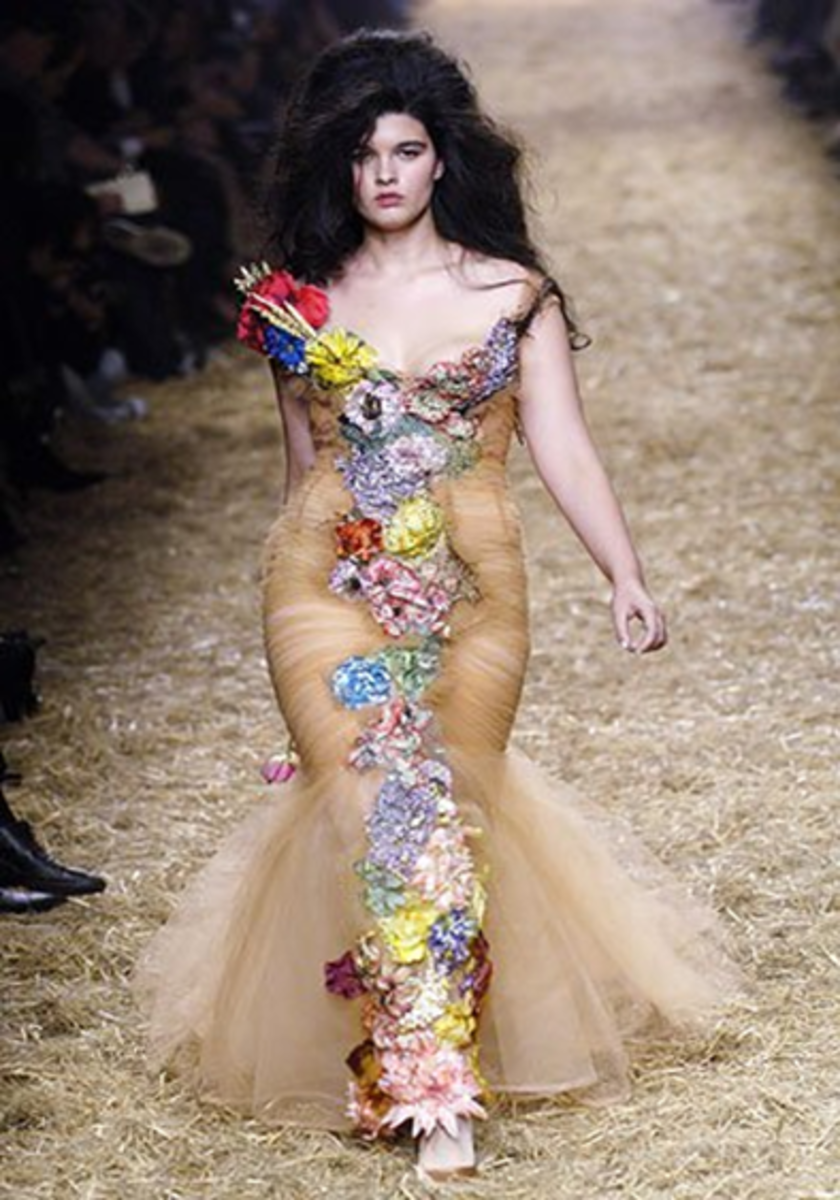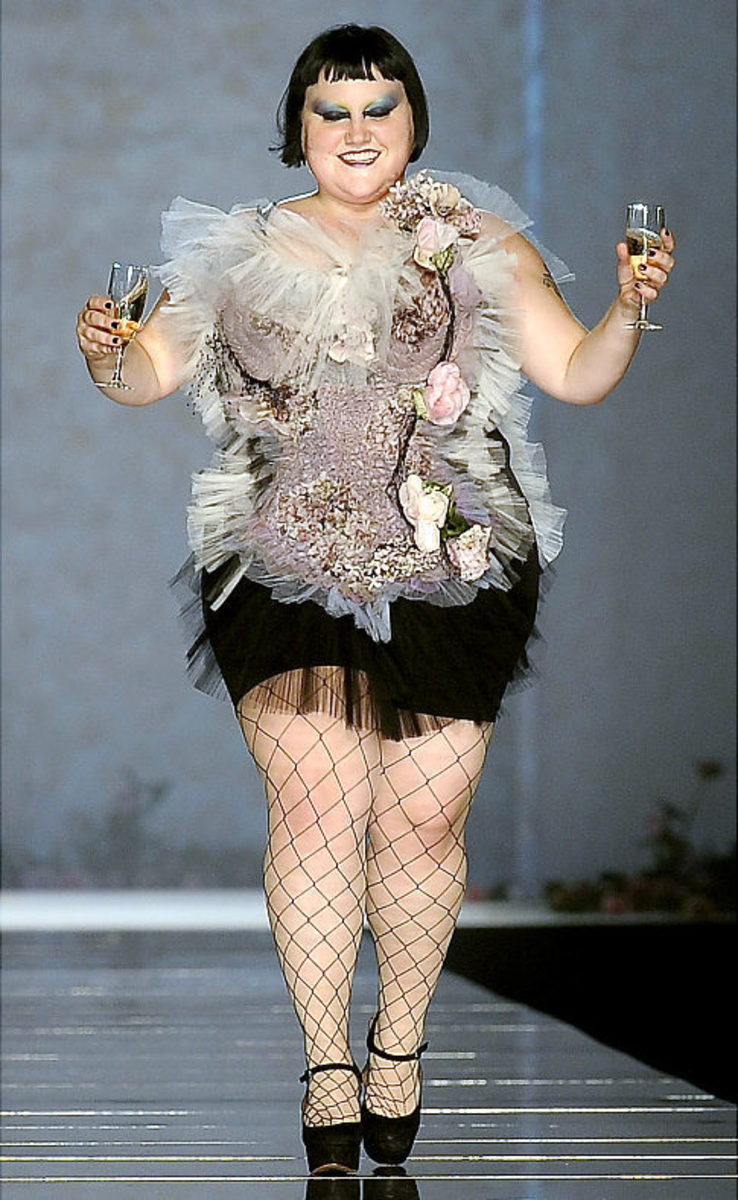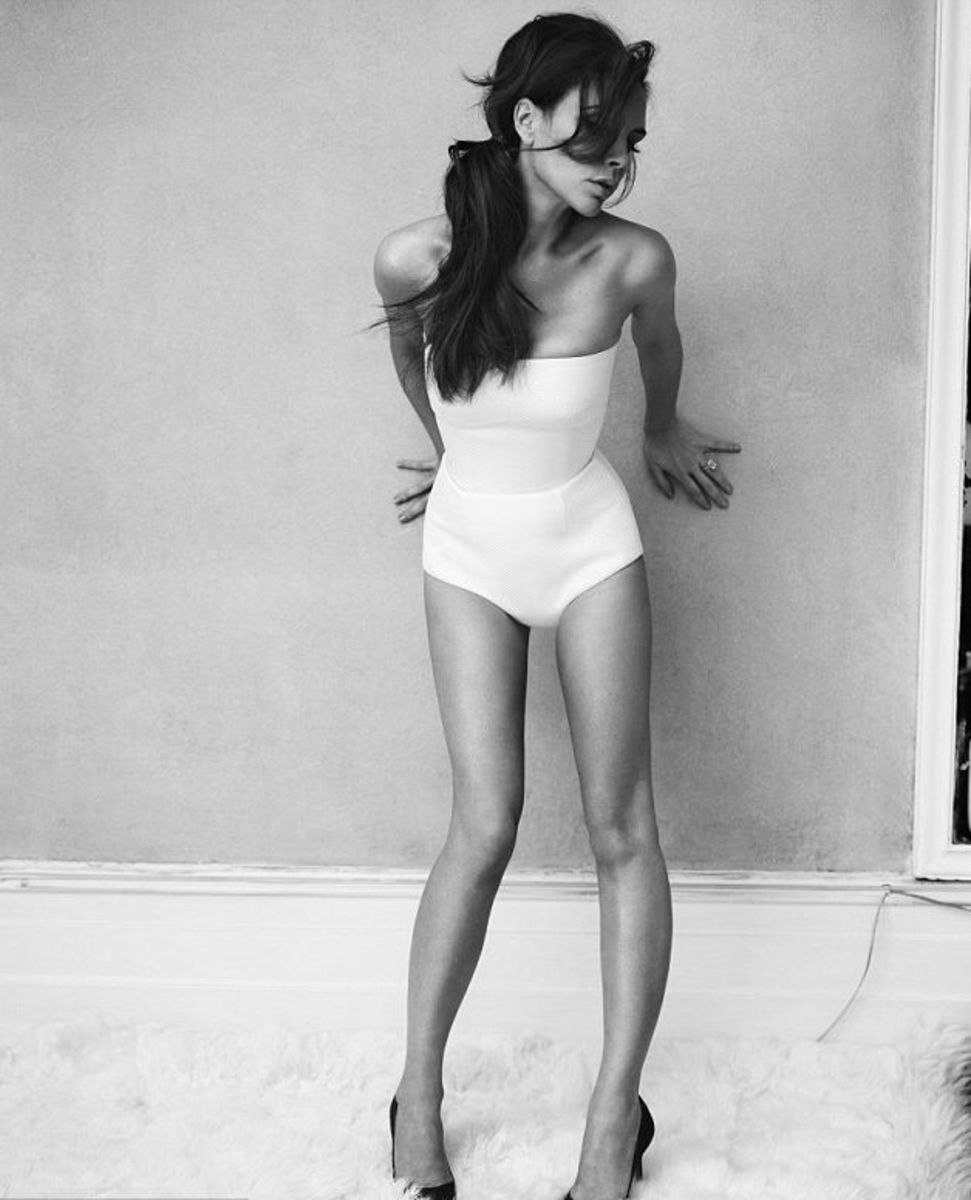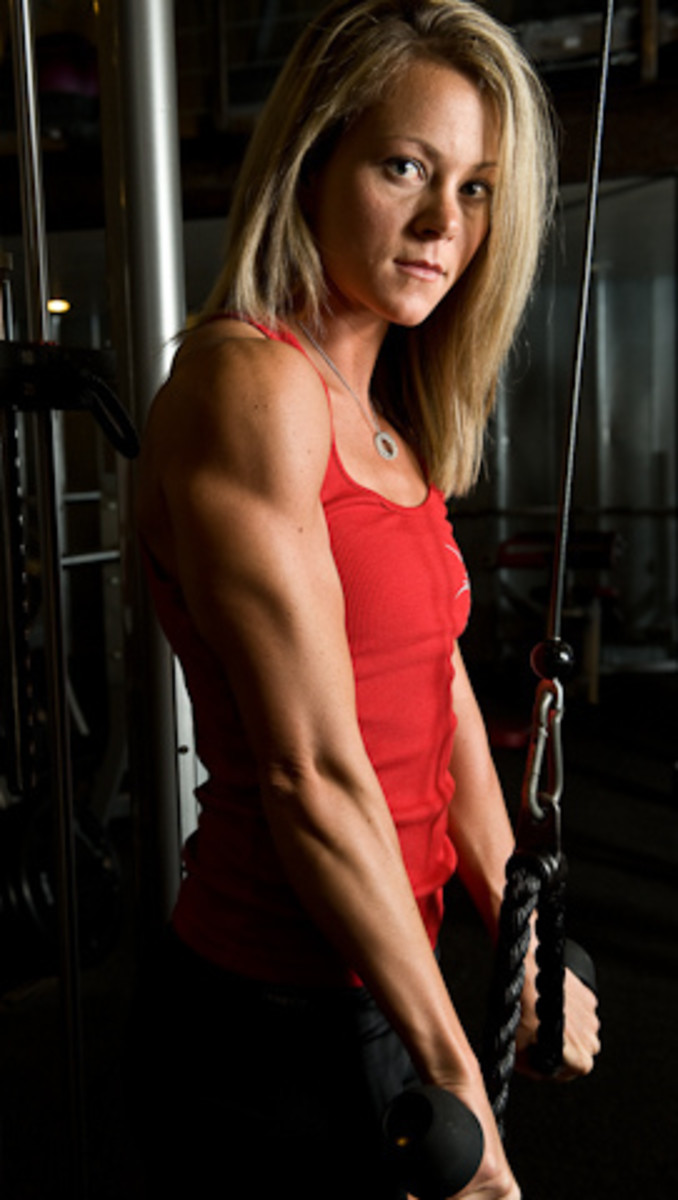Reflecting Venus

Reflecting Venus will attempt to promote understanding of "large" people among a culture that worships being thin. Reflecting Venus will attempt to show that obesity is not a sin, moral failing or lifestyle choice. Reflecting Venus believes that even if obesity were any of these things that still would not give anyone the right to treat "large" people as sub-human.
Being healthy has nothing to do with your weight. You can weight 200 pounds and still be an Olympic athlete. Losing weight for health reasons is fine as long as it is done in a sensible and healthy way. Starving yourself for beauty is just stupid.
This lens will be a collection of anything I find that has to do with positive self esteem for fat people.
Image:Venus at the Mirror by Peter Paul Rubens c. 1614-15
The Horrible Truth
"11% of the respondents in a recent survey said that, if a genetic predisposition to obesity was identified in their unborn children, they would opt for abortion." - Terry Poulton: No Fat Chicks

What's The Big Deal?
The Issue is NOT:
Whether or not anyone finds us attractive. Some do, some don't (like thin people)
The Issue is NOT:
Whether fat people are healthy. Some are, some aren't (like thin people)
THE ISSUE IS:
Whether people's perceptions of us give them the right to treat us like sub-humans.
It is time for fat people to just say NO to bigots!
Now Casting in LA for: Big Girls Club X
Press Release
DORON OFIR CASTING IS PROUD TO ANNOUNCE THE OFFICIAL CASTING FOR:
B I G Girls Club - casting in LOS ANGELES only
VH1 in association with Doron Ofir Casting and Left Right Productions is now casting the hottest, most bodacious, voluptuous single women who are in LOS ANGELES only, at least 21 years old and appear younger than 35 to represent the BBW's in a brand new docu-series that will show a long-awaited glimpse into the ultra-fab world of big girls! If you have your cake and eat it too, we want to hear your story.
You're big and beautiful and know how to own it! You're phat, fab and chic and have the big and bold personality to match. You've got the style, sex appeal and sass to get noticed without being a sample size.
Time to show the world that big girls have more fun!
Whether you're nightlife's A-list, a full-sized fashionista, big and business savvy or singlin' and minglin' with L.A.'s hottest, we want to meet you!
Step aside skinny bitches, the spotlight isn't big enough for the both us.
Big girls don't cry… they freakin' party!
If you are interested please Email BigGirlsClubCasting@gmail.com with your Name, Age, Phone Number, A Short Bio and 2 recent photos.

Marie Clair Blog Controversy
By now, most of you have probably heard about the Marie Claire blog post by Maura Kelly where she says she finds fat people "aesthetically displeasing" and compares them to junkies among other things. I'm happy that thousands of people have contacted the magazine demanding that Kelly be fired. I think the editors who approved the post should be fired as well. They wouldn't have dared to print it if the word "fat" had been the word "gay" or "black" or "disabled" but they didn't bat an eye at taking a swing at overweight people.
Nobody is really saying much about what started the fuss in the first place. Kelly was asked to write about the new comedy, Mike & Molly, that features two overweight people falling in love and struggling with their weight issues. Mike & Molly creator Mark Roberts has jumped into the fray commenting that "it seemed like something someone would say when they're really drunk at a party with their other hateful friends, but may be not good to write down and put it out for people to look at."
Would drunkenness be a reasonable excuse for such hateful comments? Even though Kelly wrote an apology the things she wrote are out there forever painting her as a complete bitch. When writing online it's good to remember the saying: "things said in haste are often repented of in leisure." It's really sad that a "women's" magazine would print such negative body hating stuff. Women are told that there is something wrong with them often enough as it is. They don't need a magazine spitting out garbage.
On the plus side, we now know where Kelly and Marie Claire stand. Their prejudices are front an center, not merely hinted at by their air brushed photos and size 0 fashions. We now know that we shouldn't be giving our money or our time to a business that treats us like second class citizens. Will this make Marie Claire change? I doubt it. For every one woman who cancels her subscription there are ten more renewing theirs.
Edit: Digging a little deeper into this issue I find that Marie Claire is now posting a "series of counterpoint posts to blogger Maura Kelly's opinion piece." It's almost as if they had them ready to go and all they were waiting for was the first blog piece to stir things up. How many of us even knew Marie Claire had a blog before the newswires and fat acceptance advocates got wind of the offensive post? And how many of us are going to go back every day and read the "counterpoint" articles. This must be a huge jump in their web stats. Not that I'm cynical.
How many of us are going to check out Mike & Molly? I just tracked down a few episodes online (I don't have a TV) when I had no intention of watching the show before today. So win for the shows creators. I guess there really is no such thing as bad publicity.
Fat Talk Free Week - Oct. 18 - 22, 2010
Fat Talk describes all of the statements made in everyday conversation that reinforce the thin ideal and contribute to women’s dissatisfaction with their bodies. Examples of fat talk include: “I’m so fat,” “Do I look fat in this?” “I need to lose 10 pounds” and “She’s too fat to be wearing that swimsuit.” End Fat Talk

Club Bounce
Club Bounce is a night club that caters to BBW (big beautiful women), BHM (big handsome men) and those who admire us. People of all shapes, sizes, backgrounds, race and style come to Club Bounce to enjoy the accepting atmosphere, awesome music and good times!
Danza Voluminosa
Danza Voluminosa, Dance Company
Today Danza Voluminosa consists of seven dancers (six women and one man) and Juan Miguel Mas, choreographer-producer. It provides a context for obese people to develop artistically, to create a language and a structure that makes them able to interact with society. In fact Danza Voluminosa is like any other professional dance troupe, only heavier.
PETA Retreats, Removes Anti-Fat Ads - Press Release from ISAA

The People For The Ethical Treatment of Animals (PETA) has seen reason and removed the offensive Save The Whales! Lose The Blubber. Go Vegetarian billboard ads and replaced them with the ironic but considerably less offensive Gone Just like all the pounds lost by people who go vegetarian.
Gone as if to say to you, the public Gone! We get it. We heard you loud and clear! We removed our offensive ad and came up with something milder, okay? And thats fine. Thats all we were asking for.
This clearly shows once again that all it takes is a concentrated effort sending a simple yet very loud message to those who discriminate. With enough time and all the resources available (telephone, Facebook, MySpace, Twitter, blogs, webpages, faxes and postal mail), the offending party will get the message and if they do not wish to continue to be flooded with angry (yet peaceful) protest, which can also lead to boycotts of them financially, then they will change course and correct the problem. This works for politicians, corporations and anti-fat organizations like PETA. Thank you ALL for your participation in this activism/advocacy effort. It may seem like something small but in this case, within two weeks time, you got PETA to replace billboard ads all across the United States! And those ads were berating and hurting fat people every time they saw them, sometimes multiple times in a day. So its a big deal! Give yourselves a hand, you deserve it!
Allen Steadham, Director
Drop Dead Diva Promo
Will Drop Dead Diva encourage people to see plus sized people in a new, more positive light?
Other Interesting Stuff Found Online
- Diary of a BBW Escort
I might not send scads of letters to airlines protesting their policies, nor write Lane Bryant for their ridiculousness of using skinny models, but I hold my own on my own fat war front. I'm an escort, as I prefer to be called, and a BBW. - Healthy Obligations
The Fat Nutritionist said it best: You are under no obligation to be healthy.
Fat Documentary Promo
100% People Video
All the Cats Join In - Walt Disney - made in 1946
A very cute video. Happy kids dancing at the malt shop. What could be nicer. Too bad Disney had to point out big girls don't interest boys ( at 4:00).
Banned Lane Byrant Commercial - Posted April 22, 2010
While Victoria Secret's scantily clad models - most recently "The Nakeds" -seductively strut, prance, and dance in barely-there bras and panties in commercials across your TV screens, other models are not given the same freedom.
A new commercial for Lane Bryant's new lingerie line, Cacique, has been censored by Fox and ABC, both of which eventually agreed to air the commercial only in the final moments of "Dancing with the Star" and "American Idol" - Fox agreeing only after Lane Bryant threatened to pull the ad buy.
Lane Bryant took to their blog with their outrage:
"It appears that ABC and Fox have made the decision to define beauty for you by denying our new, groundbreaking Cacique commercial from airing freely on their networks."
"We knew the ads were sexy, but they are not salacious. Our new commercials represent the sensuality of the curvy woman who has more to show the world than the typical waif-like lingerie model. What we didn't know was that the networks, which regularly run Victoria's Secret and Playtex advertising on the very shows from which we're restricted, would object to a different view of beauty. If Victoria's Secret and Playtex can run ads at any time during the 9pm to 10pm hour, why is Lane Bryant restricted only to the final 10 minutes?"
I'll tell you why. Because we live in a world where beauty is narrowly defined as being thin and slender. Anything else is simply unacceptable. Sure, print magazines have made strides in incorporating plus-size models in various magazines, but this a giant step backwards.
One of the networks even claimed that the woman in Lane Bryant's commercial has "too much cleavage." It's a lingerie commercial. Isn't cleavage the point? And why are Victoria's Secret models allowed to have cleavage but plus-size models aren't?
Take a look at the offending commercial yourself:
What do you think? Too much cleavage or skin? Not any more than a Victoria's Secret commercial - that's for sure.
So, why the unfair treatment? Are plus-size women not allowed to be sexy or wear lingerie? They should and do and I'm glad Lane Bryant has created a line of lingerie for the fuller figured woman. Now we just need the networks to follow suit.
Do you think the commercial should be censored?
These Bodies are Beautiful at Every Size - Glamour September 21, 2009
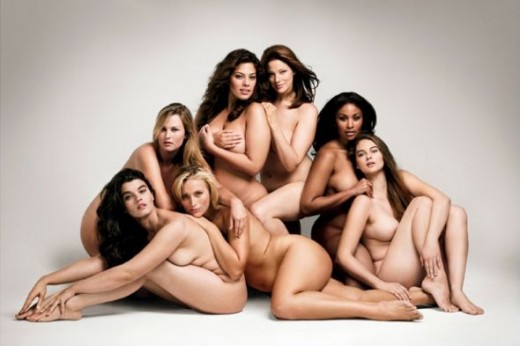
The cavernous photography studio in New York City is bustling with fashion assistants, hair and makeup stylists, and models chatting in white terry robes. All typical on a photo shoot, but when the robes come off, you see what's different. Kate Dillon, Ashley Graham, Amy Lemons, Lizzie Miller, Crystal Renn, Jennie Runk and Anansa Sims- some of the top "plus-size" models working today-have beautiful curves, round shoulders, belly rolls and lots of other womanly stuff many of us see when we look in the mirror. Oh, and there's lunch, which the models actually eat. "Gosh, it's so nice that they're feeding us," says Lemons. "When I was doing runway, all I was ever offered was water and champagne, all day long." But it's not the food the models are excited about-it's the mission. They've been assembled to help Glamour continue an extraordinary dialogue on body image that you, our readers, began.
It started in our September issue with a small photo of Lizzie Miller sitting au naturel-confident, sexy and clearly unconcerned about a little belly overhang. We loved the photo, but it was just one of more than a hundred of full-figured women we've run in recent years, so we were surprised when it hit a nerve. "This is true beauty!" wrote one commenter on glamour.com. "A woman that eats!" Added Megan Fehl, 23: "Because of my own belly, I always thought I was some deformed woman, but not now. Holy hell, I am normal!" And in the words of another reader: "I've struggled with eating disorders and body image since I was 12. Seeing this picture is the first time I have felt good about myself and comfortable with my body (just the way it is) in a very long time. Thank you for the self-esteem."
Why did this particular picture, at this particular moment, resonate with so many women? Some possible reasons: The recession has us all in a back-to-basics, tell-it-like-it-is mood, so realer images of women's bodies seem appropriate now. Celebrities like Kate Winslet, Jessica Simpson and now, on page 182 of this issue, Scarlett Johansson have spoken out against a culture that nitpicks a woman's every thigh dimple. First Lady Michelle Obama dresses to accentuate rather than camouflage her regal curves, and has the entire world swooning. And maybe, as Emme, a pioneer plus-size supermodel and host of More to Love, believes, "we've just had it with the beyond-slender, airbrushed-from-head-to-toe models and actresses who've dominated [newsstands] for over a decade."
Glamour has been on this wavelength since the early nineties. We've put Queen Latifah on the cover twice and frequently feature other fuller-bodied celebs and models (including all the women you see here, with the exception of Glamour newcomer Jennie Runk). But the phenomenal response to the Lizzie Miller photo shows there is a thirst for an even more inclusive view of women's bodies. So what's keeping the fashion and media worlds from portraying as many size 10's and 14's and 20's as we do size 0, 2 and 4? And what ratio of fantasy to reality does the average American woman really want to see in magazines and ads?
It All Starts With the Clothes
Let's say you fit the most popular American dress size, a 14, and you want to wear high-end designer fashion. Good luck to you, because most designer fashion labels don't make a size 14 (they stop at 10 or 12). That's an aesthetic decision, not a business move, says Marshal Cohen, chief industry analyst for the market research firm NPD. "We know that larger-size women will pay almost anything for good-quality clothes that fit, and luxury brands could benefit greatly from serving that need," he says. "But there remains a deep stigma against going plus-size in the high-end fashion market. Find a brand that's willing to bet its image and licensing revenue by doing this, and you will find a progressive company."
Such companies do exist, and kudos go to Michael Michael Kors, Isaac Mizrahi for Liz Claiborne New York and Baby Phat, among others, for making chic clothes in sizes larger than 14. But even if more designer fashion came in plus sizes, you'd still rarely see it modeled in a magazine by plus-size girls. Why? It's the sample-size problem. When fashion editors do photo shoots, they can't simply buy clothing that's in stores now. They need samples of clothing that will be available when the magazine hits newsstands-samples made by the manufacturer and cut, almost always, to fit a woman size zero to 4. When Glamour uses models and celebrities who are larger than sample-size, getting of-the-moment fashion for them "can be a challenge," says Maggie Mann, senior fashion editor. "We'll have a tailor standing by, doing alterations and opening up seams. And we might buy clothes off the rack if we can find something that'll be available months later when the issue comes out." Major celebrities have it a little easier; a designer will occasionally make a dress in her size as a courtesy, as happened when Queen Latifah was Glamour's cover girl.
In June, Alexandra Shulman, editor-in-chief of British Vogue, wrote a letter to top designers, begging for reform. "We have now reached the point where many of the sample sizes don't comfortably fit even the established star models," read a portion of her memo, quoted in The Times of London. She charged that designers were forcing magazines to hire models with "jutting bones and no breasts or hips." Strong words. Will they make an impact? "We hope so. It will take a season or two before we know," says Glamour deputy fashion director Sasha Iglehart. "Crystal Renn has already graced Glamour's pages multiple times. It would be a dream come true to work with beauties like her dressed in our favorite designers and brands."
Looking Into a "Skinny" Mirror
The sample-size problem means that standard-size models are slim. But guess what? Plus-size models aren't all that "plus." "At most modeling agencies, any girl larger than a size 4 might have trouble getting work because she won't fit the clothes, and over a size 6 she might be moved to the plus division," says Glamour senior bookings editor Jennifer Koehler. "There's a shortage of truly plus-size girls to choose from, and every other week I'm e-mailing the agencies asking, 'Do you have any new size 16s?'" Often the answer is no, she says, because there still isn't enough work to employ them.
Jennie Runk, a size 12, admits she's often much smaller than the plus-size samples she models, so "I'll sometimes wear padding." Did she say padding? Indeed she did: "I travel with my own set. It's a series of foam ovals and circles you can put on your butt, hips, waist or boobs so you fit the clothes," Runk explains. Many commenters on Glamour's picture of Lizzie Miller felt that, given her actual size, the term "plus" shouldn't apply. "This girl is normal," wrote one reader. "Redefine plus-size for me again? Is every woman over 120 pounds and a size 2 considered 'plus' now?"
Not all commenters lauded the photo, however; a sizable minority objected to it on health grounds. "Putting a young model who is obviously overweight and living an unhealthy lifestyle in your magazine to make some people feel better only serves to propagate that unhealthy lifestyle," wrote Angie E., 44. Another reader took that criticism a few steps further: "We have enough problems with obesity in the U.S. and don't need your magazine promoting any more of it. Shame on Glamour for thinking this was sexy!"
Obesity is a significant health problem. But let's check the facts: At 5'11" and 180 pounds, Miller, who exercises and eats a balanced diet, is "just barely overweight, according to her BMI. She is healthy and far from being obese," says Hilda Hutcherson, M.D., a clinical professor of obstetrics and gynecology at Columbia University. Dr. Hutcherson also notes that beautiful images of bigger bodies can help women feel good about themselves. "The first step to taking better care of yourself is having self-respect," she says. Glamour assistant editor Margarita Bertsos, who documented her 75-pound weight loss on glamour.com, is living proof. "Being told that I must occupy Barbie proportions in order to be beautiful is definitely not what motivated me to lose weight," blogged Bertsos. "In fact, those beliefs are what kept me obese for so many years. It's when I made the shift toward self-acceptance that I finally found the motivation to lose weight."
Body Positive Articles in Glamour Magazine
- Exclusive Body-Image Survey: 16,000 Women Tell Their Body Confidence Secrets
We at Glamour think your body is fantastic. Tall and gangly, small and busty, muscular, curvy, soft or sinewy—we celebrate it all. Men, we discovered, feel pretty much the same way. Trouble is, too many of you don’t. Twenty-five years after our first - Do You Have a Healthy Body Image?
When we were young, we were taught that our bodies are perfect just the way they are. But somewhere along the way, that ideal became skewed—skewed by stick-thin runway models, too-toned-for-their-own-good celebrities and an unhealthy standard of what - What No One Ever Tells You About Losing Weight
The world watched assistant editor and Body by Glamour blogger Margarita Bertsos transform herself inside and out. Here's how she succeeded. You can too. - Body Image: Do Certain People Make You Feel Fat?
I had the most interesting conversation with my friend L. yesterday. She said: "I dread hanging out with M. [a mutual friend] because she just makes me feel fat!" Here's the thing, I think her comment was very honest and real. Does your body image fl - What It's Really Like To Walk The Runway (According to One of Our Fave Real Size Models!)
Good news, lovely ladies! I'm happy to report that Mark Fast wasn't the only designer to feature real size models on their runway this season! This morning in Milan, dozens of real size models hit the catwalk to show off Italian plus-size designer E - Should Friends Be Comparing Each Other's Body Sizes?: Shape Up!
You guys know that since I started this shaping up journey, I’ve encountered all sorts of reactions from people. They range from really positive, like when I rocked that outfit to a wedding recently, to really hurtful, like the time my grandmother as - Do You Find This Anti-Obesity Ad Offensive?
PETA's always been an outspoken group with unusual tactics, so I'm not that surprised by their new billboard campaign which seems to use fat-shaming as a way to try and turn people on to vegetarianism
The Fast and the furious: Stylist at London Fashion Week resigns over designer Mark Fast's decision to use size 14 models - Daily Mail 24th September 2009
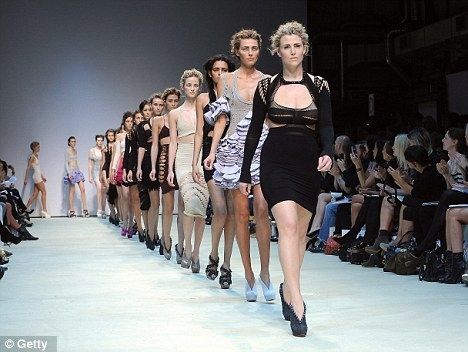
Preparing for his London Fashion Week slot, knitwear designer Mark Fast decided to challenge the obsession with size zero models and use curvier women to showcase his creations.
It was a bold move - and one which nearly led to his entire project unravelling.
When he told his design team that his figure-hugging outfits would be paraded down the runway by size 12 and 14 models, two of his people were apparently so angry they quit.
Big issue: A size 12 model leads the final walk-out at the Mark Fast catwalk show at London Fashion Week. The designer used size 12 and 14 girls alongside more conventional-sized models to showcase his knitted dresses
The stylist and creative designer deserted Fast, 28, just three days before Saturday's event at the University of Westminster.
The show was only saved after freelancers Daniela Agnelli and Natalie Hubbarb stepped in to help Fast, working into the early hours to ensure all the designs were ready for the big day.
Happily, it was a great success, with three models from the agency 12+ UK gracing the catwalk.
Fuller-figured: Curvier women were used to model Mr Fast's 'bodycon' dresses. In 2007, a Model Health Inquiry was launched in response to the death of several 'size zero' models. It failed to set out any firm industry guidelines
Amanda May, Fast's creative director, yesterday blamed the walkout on 'creative differences' over the use of larger models. 'There was a team change and we are glad we stuck to our vision,' she said.
'The decision to use fuller girls is something we have been talking about. There's an idea that only thin and slender women are able to wear Mark's dresses and he wanted to combat that. We wanted women to know they didn't have to be a size zero to wear a Mark Fast dress - curvier women can look even better in them.'
The models used in the show were Hayley Morley, 21, a size 12, Laura Catterall, 20, a size 14 and Gwyneth Harrison, 25, a size 12-14.
Sarah Watkinson, 37, founded 12+ UK in 2000 and has 37 models on her books.
She said: 'I'm very happy that Amanda and Mark stuck to their passion. They really wanted to do it but it was difficult for them.
'Mark has been passionate about using larger women and really wanted to show that they look great in his dresses.
'Every time I think things are progressing, they end up going back to how they've always been. I hope this has sparked lasting changes.'
Fast, a Canadian, has also been involved in the photographic exhibition All Walks Beyond The Catwalk, which features models aged 18 to 65 and sized eight to 16 wearing clothes created by young London designers.
The exhibition, which opened on Friday at Somerset House, attempts to challenge the narrow view of beauty in the fashion world.
The day before Fast's show, chairman of the Institute of Psychiatry's eating disorder team, Professor Ulrike Schmidt, had raised concerns over the use of stick-thin models.
He said: 'We are very concerned that the lack of medical checks of models at London Fashion Week, coupled by an environment where being underweight is the norm, prevents those with eating disorders into gaining an insight into their condition.'
Plus-sized model from Mark Fast's 2009 Runway Show
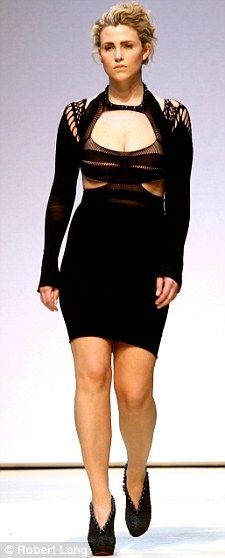
Plus-sized model from Mark Fast's 2009 Runway Show
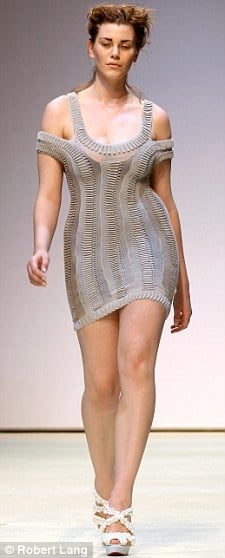
Body-Confidence Secrets From Plus-Size Model Crystal Renn - Glamour September 30, 2009

In her memoir, Hungry, 23-year-old Crystal Renn chronicles her battle with anorexia and exercise bulimia as she struggled to make it as the skinniest of supermodels. It wasn’t until she embraced her curves and became a plus-size model (that’s the modeling industry’s term for models over size 6) that her career skyrocketed. We asked the size-12 beauty how she learned to love her body and how you can too.
First, what inspired you to write Hungry?
I want women and the fashion industry to hear me and think, You know what—maybe there should be all different body types up on the runway, maybe that’s a really a great idea. I want women to be happy with who they are because I think that once they do that, all opportunities in their lives will get even bigger and better for them. Doors will be opened to them because they will be ready for it. Think about it: If you hate yourself, you don’t like your relationships, you don’t do as well at work, you don’t take all the chances that you want in your life. I would like to see women overcome that and take it to the next level.
I want women to be empowered, to be confident, to love life, and that’s why I chose the title Hungry for my book. Because it’s hungry for everything. And that’s what I want women to take away from it—to love themselves but also to accomplish your dreams.
Loving your body is one of those things that’s easier said than done. What advice do you have for women to put the thought into action?
Instead of focusing on all the bad things like, “Oh my gosh, I hate my thighs,” I say let’s look at the hair and say, “Oh wow, I’m having such a great hair day.” Or “Oh wow, my eyes are so clear today…I really like my lips….” And then eventually your mind will start to change and think of the positive things when you look in the mirror instead of focusing on the negative. It definitely takes time—it’s a habit—but just like anything else, over time, you can change the way your mind works.
So when you’re having a bad day and look in the mirror, what part of your body do you embrace to change your thought process?
There are a few things I look at on those days: I say, “Wow, I have full, great, healthy hair,” because now I eat healthy and I can see my health in my hair. That’s one thing. I also say, “Wow, I have great cheekbones. Let’s play them up, put some bronzer on them.” And then I might say, “Oh wow, I have a great waist; I’m going to show it off by belting my dress today.” Or I’ll put on some red lipstick and see how great I feel. I love wearing lipstick. It’s my feel-good-immediately move.
In your book, you talk a lot about being the size you’re supposed to be. How can women figure out what size they are supposed to be?
I refer to this as your body’s set point. Everyone is born with what they’re supposed to be. I think that you have to listen to your body, be very in tune and take the focus off the food. Eat a healthy, balanced diet, and when you crave something, have it. For instance, if you want red meat, have red meat—there’s a reason for it. If you want a cupcake, have a cupcake—and enjoy it. Start to listen to your body in that way, and I think that your body will even out to what it’s supposed to be, and you’ll be much happier for it. The second the obsession starts and the dieting starts, you’re immediately unhappy because you think you’re being starved. So when you do eat, you eat 10 times more than what you should, and you’re getting further and further away from recognizing what your body’s set point is.
What do you want people to think when they see your pictures—like the ones of you in a swimsuit or in the buff?
I want them to look at them and be like “Well, wow! She can wear a bikini, and she’s a size 12. I’m going to go wear a bikini. I’m OK. I’m OK and I’m an 8. Or I’m a 14, or a 16.” Whatever size they are, I want them to be inspired that a girl who they thought shouldn’t wear a bikini before is wearing one and looks great and healthy. I want them to feel inspired to do the same thing. I want women to be proud of their bodies, to be proud of who they are.
What is your goal for the fashion and media industries in terms of body types?
I don’t want to see only size 14’s, and I don’t want to see only size 2’s. I want to see all different women with all different shapes. I want to see all different races, all different hair colors, all different eye colors. I want to see a variety; I don’t want to be bored. And I think women will be inspired by being able to see themselves in these pictures. I understand that there’s a need for the fantasy, I completely do, but having images of girls who are so unattainable—that represent nobody—is not something that’s very positive. You can still have the fantasy, but I think the consumer wants to be able to touch it, if just a little bit.
Recomended Reading
Weight and Health, Research
Atrens, Dale. Don't Diet. New York, NY: Morrow, 1988.
Bennett, William and Gurin, Joel. The Dieter's Dilemma. New York, NY: HarperCollins, 1992.
Berg, Frances, ed. The Health Risks of Weight Loss. Hettinger, ND: Obesity and Health, 1993.
Cannon, Geoffrey, and Einzig, Hetty. Stop Dieting: Dieting Makes You Fat. New York, NY: Pocket Books, 1987.
Ernsberger, Paul and Haskew, Paul. Rethinking Obesity: An Alternative View of Its Health Implications. New York, NY: Human Sciences Press, 1987.
Gaesser, Glen. Big Fat Lies: The Truth About Your Weight and Your Health. New York, NY: Fawcett Columbine, 1996.
Fitness,
Hakala, Dee. Thin Is Just a Four-Letter Word: Living Fit - For All Shapes and Sizes. Little Brown, 1997.
Jonas, Steven and Konner, Linda. Just the Weigh You Are: How to Be Fit and Healthy, Whatever Your Size. Shelburne, VT: Chapters Publishing, Ltd., 1997.
Kingsbury, Bonnie. Full Figure Fitness. Champaign, IL: Enhancement Publications, 1988.
Lyons, Pat and Burgard, Debby. Great Shape: The First Fitness Guide for Large Women. Palo Alto, CA: Bull, 1990.
Nutrition Management
Allison, Nan, and Beck, Carol. Full & Fulfilled: The Science of Eating to Your Soul's Satisfaction. Nashville, TN: A&B Books, 1998.
Hirschmann, Jane and Munter, Carol. Overcoming Overeating. New York, NY: Fawcett Columbine, 1988.
Hirschmann, Jane and Munter, Carol. When Women Stop Hating Their Bodies: Freeing Yourself from Food and Weight Obsession. New York, NY: Fawcett, 1995.
Kano, Susan. Making Peace with Food: Freeing Yourself from the Diet/Weight Obsession. Amity Publishing, 1985.
Omichinski, Linda. You Count, Calories Don't: The Hugs TM Plan for Better Health. Winnipeg, Manitoba, Canada: Hyperion Press, 1992.
Polivy, Janet and Herman, C. Peter. Breaking the Diet Habit. New York, NY: Basic Books,1983.
Body Image/Diets/Self-Esteem
Anderson, Louie. Goodbye Jumbo, Hello Cruel World. New York, NY: Viking Penguin/Louzel Productions, Inc., 1993.
Bovey, Shelley. The Forbidden Body: Why Being Fat Is Not a Sin. London, England: Harper Pandora, 1994.
Bennett, William, M.D. and Gurin, Joel. The Dieter's Dilemma: Eating Less and Weighing More. New York, NY: Basic Books, 1982.
Brown, Catrina and Jasper, Karen. Consuming Passions: Feminist Approaches to Weight Preoccupation and Eating Disorders. Toronto, Canada: Second Story Press, 1993.
Brown, Laura and Rothblum, Esther. Overcoming Fear of Fat: Fat Oppression in Psychotherapy. New York, NY: Harrington Park Press, 1989.
Bruno, Barbara. Worth Your Weight: What You Can Do About a Weight Problem. Rutledge Books, 1996.
Chernin, Kim. The Hungry Self: Women, Eating and Identity. New York, NY: Harper and Row, 1985.
Chernin, Kim. The Obsession: Reflections on the Tyranny of Slenderness. New York, NY: Harper and Row, 1982.
Dixon, Monica. Love the Body You Were Born With: A Ten Step Workbook for Women. Berkley Group, 1996.
Douglas, Susan J. Where The Girls Are: Growing Up Female with the Mass Media. New York, NY: Times Books, 1994.
Epstein, Diane and Thompson, Kathleen. Feeding on Dreams: Why America's Diet Industry Doesn't Work - and What Will Work for You. Macmillan, 1994.
Erdman, Cheri. Live Large! Ideas, Affirmations, and Actions for Sane Living in a Larger Body. San Francisco, CA: Harper, 1997.
Erdman, Cheri. Nothing to Lose: A Guide to Sane Living in a Large Body. San Francisco, CA: Harper, 1995.
Fallon, Patricia, Katzman, Melanie A., and Wooley, Susan C., eds. Feminist Perspectives on Eating Disorders. Guilford Press, 1994.
Fraser, Laura. Losing It: America's Obsession With Weight and the Industry That Feeds On It E.P. Dutton, 1997.
Freedman, Rita. BodyLove: Learning to Like Our Looks and Ourselves. New York, NY: Harper and Row, 1988.
Garrison, Terry. Fed-Up! A Woman's Guide to Liberation from the Diet/Weight Prison. New York, NY: Carroll & Graf, 1993.
Goodman, W. Charisse. The Invisible Woman: Confronting Weight Prejudice in America. Carlsbad, CA: Grze Books, 1995.
Hall, Lindsey, ed. Full Lives: Women Who Have Freed Themselves from Food & Weight Obsessions. Carlsbad, CA: Grze Books, 1993.
Hillman, Carolyn. Love Your Looks: How to Stop Criticizing and Start Appreciating Your Appearance. New York, NY: Simon & Schuster, 1996.
Hope, Jackqueline, Big, Bold and Beautiful: Living Large on a Small Planet. Toronto, Canada: Macmillan Canada, 1996
Hutchinson, Marcia. Transforming Body Image: Learning to Love the Body You Have. Trumansburg, NY: Crossing Press, 1985.
Johnson, Carol. Self-Esteem Comes in All Sizes: How to Be Happy at Your Natural Weight. New York, NY: Doubleday, 1995.
Kaplan, Jane. A Woman's Conflict: The Special Relationship Between Women and Food. New York, NY: Prentice-Hall, 1989.
Lippincott, Catherine. Well Rounded: Eight Simple Steps for Changing Your Life...Not Your Size. New York, NY: Pocket Books, 1996.
Louderback, Llewellyn. Fat Power: Whatever You Weigh Is Right. Hawthorne Books, 1970.
The Melpomene Institute for Women's Research. The Bodywise Woman. New York, NY: Prentice-Hall, 1992.
McFarland, Barbara and Baker-Baumann, Tyeis. Shame and Body Image: Culture and the Compulsive Eater. Deerfield Beach, FL: Health Communications, Inc, 1990.
Millman, Marcia. Such a Pretty Face: Being Fat in America. New York, NY: W.W. Norton & Company, 1980.
Newman, Leslea. Some BODY to Love. Chicago, IL: Third Side Press, 1991.
Ornstein, Robert and Sobel, David. Healthy Pleasures. Addison Wesley, 1990.
Polhemus, Ted. Body Styles. London: Lennard Books Ltd., 1988.
Polhemus, Ted and the Institute of Contemporary Arts. The Body Reader: Social Aspects of the Human Body. London: Penguin Books Ltd., 1978.
Poulton, Terry. No Fat Chicks: How Big Business Profits Making Women Hate Their Bodies - How to Fight Back. New York: Carol Publishing Group, 1997.
Roberts, Nancy. Breaking All the Rules: Feeling Good and Looking Great No Matter What Your Size. New York, NY: Penguin, 1985.
Rose, Laura. Life Isn't Weighed on the Bathroom Scales. Waco, TX: WRS Publishing, 1993.
Rodin, Judith. Body Traps: Breaking the Bonds That Keep You from Feeling Good About Your Body. New York, NY: William Morrow, 1992.
Schoenfielder, Lisa and Wieser, Barb. Shadow on a Tightrope: Writings by Women on Fat Oppression. San Francisco, CA: Aunt Lute Books, 1983.
Schroeder, Charles. Fat Is Not a Four Letter Word. Minneapolis, MN: Chronimed Publishing, 1992.
Schwartz, Hillel. Never Satisfied: A Cultural History of Diets, Fantasies and Fat. New York, NY: Doubleday, 1986.
Schwartz, Hillel. Pound Foolish: The Tyranny of Thinness. New York, NY: Free Press, 1986.
Seid, Roberta. Never Too Thin: A History of American Women's Obsession with Weight Loss (Why Women Are at War with Their Bodies). New York, NY: Prentice Hall, 1989.
Stearns, Peter. Fat History: Bodies and Beauty in the Modern West. New York University Press, 1997.
Thone, Ruth Raymond. Fat - A Fate Worse Than Death: Women, Weight and Appearance. Hawthorne, 1997.
Wann, Marilyn. FAT!SO?: Because You Don't Have to Apologize for Your Size. Berkley, CA: Ten Speed Press, 1999.
Beauty/Fashion
Harper, Ann and Lewis, Glenn. The Big Beauty Book: Glamour for the Fuller-Figure Woman. New York, NY: Holt, Rinehart & Winston, 1982.
Head, Sandy. Sizing Up: Fashion, Fitness, and Self-Esteem for Full-Figured Women. New York, NY: Simon & Schuster, 1989.
Marano, Hara. Style Is Not a Size. New York, NY: Bantam Books, 1991.
Nanfeldt, Suzan. Plus Style: The Plus Size Guide to Looking Great. Plume Books, 1996.
Olds, Ruthanne. Big & Beautiful. Washington, DC: Acropolis Books Ltd., 1982.
The Body Shop. The Body Shop Book: Skin, Hair and Body Care, London: Little, Brown and Company, 1994.
Wolf, Naomi. The Beauty Myth: How Images of Beauty Are Used Against Women. New York, NY: William Morrow, 1991.
Children and Teens
Hirschmann, Jane and Zaphiropoulos, Lela. Preventing Childhood Eating Problems: A Practical, Positive Approach to Raising Children Free of Food & Weight Conflicts. Carlsbad, CA: Grze Books, 1993.
Hirschmann, Jane and Zaphiropoulos, Lela. Solving Your Child's Eating Problems. New York, NT: Fawcett Columbine, 1989.
Ikeda, Joanne. Am I Fat? Helping Young Children Accept Differences in Body Size. Santa Cruz, CA: ETR Associates, 1992.
Jasper, Karin. Are You Too Fat, Ginny? Toronto, Ontario, Canada: Is Five Press, 1988.
Liddell, Sharon. Being Big. LPC InBook, 1994.
Matiella, A.C. Positively Different: Creating a Bias-Free Environment for Young Children. Santa Cruz, CA: ETR Associates, 1991.
Newman, Leslea. Fat Chance. New York, NY: G. P. Putnam's Sons, 1994.
Orenstein, Peggy in association with the American Association of University Women.Schoolgirls: Young Women, Self-Esteem, and the Confidence Gap. New York, NY: Doubleday, 1994.
Passen, Lisa. Fat, Fat Rose Marie. New York, NY: Henry Holt, 1991
Barbara Brickner
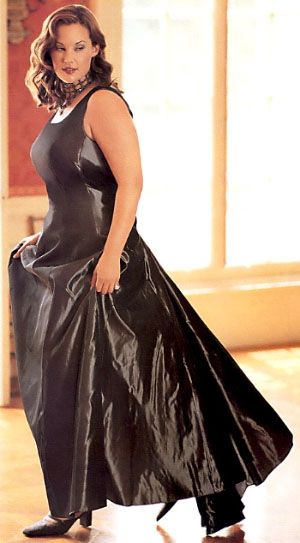

Before You Believe the Hype
As sample of how a "scientific study" can be hijacked.
Size Acceptance Organization Challenges U. of Pennsylvania Weight Watchers Study
The International Size Acceptance Association (ISAA) has discovered startling information that casts doubt on the recent study which declared Weight Watchers a better diet plan than all others. ISAA is making this information available to the public, as the public has a right to know.
The International Size Acceptance Association (ISAA) is seriously concerned about the credibility of the recent University of Pennsylvania study which essentially endorses Weight Watchers over other diet plans. A representative of the American Dietetic Association was also quoted as a supportive source in the article about the study. Upon conducting ISAA's own research, we have learned the following:
- Shiriki Kumanyika, PhD, RD, MPH, the Associate Dean for Health Promotion and Disease Prevention at the University of Pennsylvania School of Medicine is also a member of the Weight Watchers Scientific Advisory Board - Source: http://www.weightwatchers.com/about/his/board.aspx
- The American Dietetic Association has received funding from numerous companies and receives underwriting for "facts sheets" on topics related to the companies' products. Major ($100,000+) donors include: Kellogg, Kraft Foods, WEIGHT WATCHERS INTERNATIONAL, Campbell Soup, National Dairy Council, Nestle's USA, Ross Products Division of Abbott Labs., Sandoz, Coca-Cola, Florida Department of Citrus, General Mills, Monsanto, Nabisco, Procter & Gamble, Uncle Ben's, Wyeth-Ayerst Labs. - Source: http://www.cspinet.org/integrity/nonprofits/americ...
With this information, the University of Pennsylvania study appears to simply become an advertisement for Weight Watchers, potentially to the benefit of the University of Pennsylvania and the American Dietetic Association.
At the very least, ISAA believes that this indicates a lack of objectivity and conflict of interest. ISAA feels the public has a right to know these facts in determining whether the study poses relevant information or is in fact propoganda.
ISAA does not endorse weight loss dieting, instead recommending fitness and healthy food choices in combination with improving self-esteem.
ISAA's mission is to promote size acceptance and help end size-based discrimination throughout the world by means of advocacy and visible, lawful actions.
Contact Information:
Allen Steadham, Director
International Size Acceptance Association
Voicemail: 512.371.4307
Something to Think About
"You can have the life you want in the body you already have!"
Cheri K. Erdman: Nothing To Lose

Healthy Body Esteem Press Release
Released July 18, 2003
AUSTIN, TEXAS - The International Size Acceptance Association (ISAA) has launched the Healthy Body Esteem campaign to provide an escape route from the "diet-of-the-day" pressures and gloom-and-doom predictions about size and weight that assault people every day. Instead, Healthy Body Esteem encourages people to feel better about themselves and start living happier and healthier.
"People get so many conflicting messages about what is healthy and what is attractive," ISAA Director Allen Steadham said. "The same thin celebrities who were being glamorized in recent years are now being airbrushed to look even thinner on magazine covers. That sends a terrible message, both to the celebrities and to the public."
"ISAA's message is simple and to the point: love your body, it's the only one you have," Steadham said. "You have to take care of yourself - and that starts with self-esteem."
The Healthy Body Esteem webpage on the ISAA website contains downloadable graphics, wallpapers for computer desktops (also usable as posters), an Adobe Acrobat PDF file and a Powerpoint Presentation.
To learn more about ISAA's Healthy Body Esteem Campaign, please visit its website.
ISAA also has an online magazine, Without Measure, at and an internet radio show, The ISAA Rapport.
ISAA's mission is to promote size acceptance and to help end size discrimination throughout the world by means of advocacy and visible, lawful actions.
Books: Weight and Health Research
Eliza Carthy
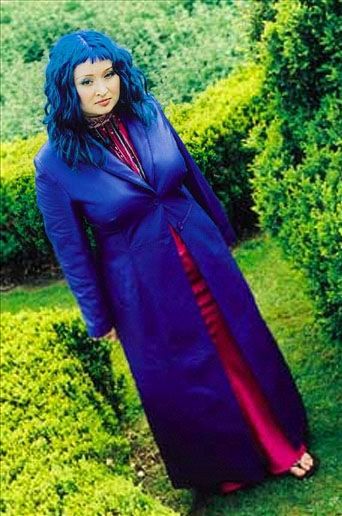

Beyond Bridget
New York Times - July 16th, 2003
Move over, Bridget Jones! There's a new chick-lit heroine in town, and she's just as likely to sport saddlebags as stilettos. Think of it as "fat chick" lit. Ever since Helen Fielding's "Bridget Jones's Diary" all but created the chick-lit genre in 1998, there has been an onslaught of novels about size-8 singletons searching for the perfect man. And even if these girls-in-the-city wore - gasp! - a double-digit size, they'd diet before book's end. But in a slew of new works, the central characters are getting their man without giving up their cake.
"I've seen a trend for not just average-sized, but large-sized characters," says Margaret Marbury, a senior editor at Red Dress Ink, a chick-lit imprint owned by Harlequin. Red Dress is planning to release several books with plus-size protagonists in the coming year, including "Inappropriate Men," which has a size-24 siren who isn't afraid to be sexy.
"What fascinated me when I first saw this book is that the character had such self-confidence and sex appeal," says Marbury. "She doesn't at all try to lose weight or make any excuses for who she is."
'Big, Jewish and sarcastic'
Whether this is a new trend or simply an evolution of an existing genre, it's resonating with readers. Jennifer Weiner's "Good in Bed" (Washington Square Press, $14), which many say helped open the door for heavier characters, spent nearly a year on the best-seller lists, and is being developed into a series for HBO. (Weiner has said she doesn't want a normally thin actress like Rene Zellweger, who plumped up for her Bridget Jones role, to portray her heroine, Cannie Shapiro.)
"My big hope is that they find some talented young actress who's been told her whole career that she needs to lose weight in order to work, and tell her that she's perfect just the way she is," she says.
"Jennifer wrote about a segment of the population that wasn't used to reading about themselves," says Greer Hendricks, a senior editor and vice president at Atria, a division of Simon & Schuster, and the editor of "Good in Bed." "I think that's what really made it fly off the shelves."
Reader Lisa Gesson agrees. "I felt like I could identify with Cannie," says Gesson, 28, an advocate for the disabled who lives in Manhattan. "We're both big, Jewish and sarcastic. It's nice to read something that I can actually see myself in."
And Gesson isn't alone in her appreciation of fat fiction. Jennifer Henderson, a 31-year-old homemaker in Castine, Maine, runs Dangerously Curvy Novels (www.curvynovels.com), a Web site that reviews books with heavier heroines. "I was getting pretty tired of the 'Barbie Doll Goddess' sort of heroine I'd seen so much of in other novels," says Henderson, who, at size 16, considers herself average, but concedes that's she's plump by Madison Avenue standards.
After reading a review of "Good in Bed," Henderson wondered if there were other stories that appealed to her demographic - women who had spent years battling their weight and low self-esteem, but were now "living large and loving it." In response, she launched the site - part personal reading list, part "you're-not-alone" inspirational therapy (each review begins with an assessment of the main character's size) - and a monthly newsletter.
Her curvy readers suddenly have a lot of literary ladies to look up to. There's Josephine Fuller, the chubby crime-solver in Lynne Murray's mysteries. And in Laurie Notaro's "Autobiography of a Fat Bride" (Villard, $12.95), there's a photo of Notaro on her wedding day, having "completely abandoned the effort of sucking her stomach in."
Breaking down boundaries
Wendy Shanker, a humor columnist and author of the forthcoming nonfiction title "The Fat Girl's Guide to Life," thinks it's about time fat women got some respect. "There are just so many of us, we might as well get some props," she says. "Even if we don't look like Rene Zellweger, we still fall in love, we have affairs and romances."
In fact, even romance novels, traditionally more escapist fare, are hewing closer to reality. In "Blushing Pink" (Onyx Books, $6.99), Reese Brock still has bodice-ripping sex scenes - only this time, they involve a potbellied body. "There were a lot of 'don'ts' in romance novels. You would never have a certain age or a certain weight," says Amy Pierpont, a senior editor at Downtown Press/Pocket Books. "But as times have changed and readers' tastes have changed, boundaries are being broken right and left."
Jenny Bent, a literary agent with the Harvey Klinger agency who represents Notaro, speculates that this new breed of chick-lit novels has a "warts-and-all" appeal. "It's not about women who make us feel bad about ourselves," she says. "It's women who look like us. It's real women."
Jane Monheit


Resort That Caters to Plus-sized Travelers
USA Today - July 10, 2003
TANKAH, Mexico — As a savvy traveler, Sandy Polley meticulously researches her vacation spots. She prefers the beach, likes to splurge on upscale resorts and enjoys indulging in spa treatments. Before booking a hotel, she peruses the Internet for photos and critiques from fellow travelers.
Then she conducts her own reconnaissance.
Is the swimming pool equipped with plaster steps or an aluminum ladder? Are the beach chaise lounges made of sturdy wood or flimsy plastic? Are the facilities in a compact area or so spread out that they require lots of walking?
"I always scout out what hotels are appropriate for people my size," says the 33-year-old Web designer from Bloomington, Ill., who is attractive, articulate and large.
So when she heard about Freedom Paradise, a new hotel that bills itself as the world's first "size-friendly" resort, she packed the bikini she had never before worn in public and headed to a secluded, sun-kissed bay 75 miles south of Cancun. Her reasoning was straightforward.
"I expect to be treated with respect, and a place like this might be a catalyst for change. They have family resorts, gay resorts, couples resorts. Why not one for us?"
Why not, indeed?
"It was so obvious," Freedom Paradise's creator, Julio Rincon, says of the concept. As the manager of a Cancun hotel for the past five years, Rincon had only to open his eyes for inspiration. "The average-size person doesn't exist anymore," he declares.
In fact, two-thirds of American adults are overweight. And 27% of those are considered obese, defined as having a body-mass index (which incorporates height and weight) of 30 and above. Worldwide, an estimated 300 million people are obese.
Health care professionals might see cause for alarm in those statistics. But Rincon and his partner, Jurriaan Klink, see opportunity.
They've coined a slogan: "Live Large — Live Free." And a message: "Don't wait until you lose weight. Enjoy your life today." They've leased two adjoining hotels about 4 miles north of the Mayan ruins at Tulum, adapted the facilities for the plus-size vacationer, and opened in June. The straight-backed chairs in the dining areas are armless; some are twice the standard size. Guest-rooms have walk-in showers. Many doorways are wider than 37 inches. A handful of suites have 47-inch entryways and seats in the showers. On the beach, sturdy sun beds are built for two — or just one. The lobby gift shop carries golf shirts and shorts up to size 5X. (Los Gorditos y los Grandotes son Nuestros Consentidos! read the labels. Loosely translated: "We Spoil the Fat and the Obese!") Benches at the beachfront bar have tree-trunk legs.
Breakfast and lunch buffets at the all-inclusive, all-you-can-eat resort include all the food groups, and then some. Typical midday fare includes beef, fish, pasta, rice, soup, salad, bread and desserts. Other dining areas serve seafood and Italian and Mexican dishes.
The 112 guestrooms are comfortable but basic, with queen- or king-size beds and roomy patios or balconies. Amenities in both buildings are similar, though the exterior designs are distinctive. On one side of the resort, beachfront rooms are in two-story Mexican colonial-style buildings whose custard-, cotton-candy- and blueberry-stucco exteriors look as if they had been iced. Other buildings sport similar hues, with Caribbean-style palm-thatched roofs and rooms that overlook gardens. The grounds are lush with hibiscus and coconut palms; the new proprietors have added two swimming pools to the existing two.
Freedom Paradise may be the first vacation spot of its kind, but merchandisers such as clothing and furniture designers increasingly are catering to a plus-size world.
"It's really nice to see when manufacturers realize fat folks' money is just as green as other people's," says Frances White of the National Association to Advance Fat Acceptance. "It's about time people acknowledged that there's no such thing as one size fits all."
But Rincon stresses that size acceptance goes beyond physical accommodations. He's recruiting plus-size employees. And he hired a psychologist to give the staff sensitivity training.
"This is a place where you can go and nobody will point" if you have another helping, Klink says.
They prefer the term "size-friendly" because the resort is meant to cater to friends and families of the plus-sized.
So obvious was his idea, Rincon says, that he kept mum about it during its three-year development for fear a competitor would beat him to the punch. He tells his story over bowls of velvety chile con queso and warm tortillas in Cielito Lindo, one of the hotel's five dining areas. With his compact physique (the 51-year-old is a competitive swimmer), it wasn't personal experience that brought him to this proposition. The same goes for the Dutch-born Klink, 28, who is Lance Armstrong-lean and has resorted to supplementing his diet with protein shakes to beef up.
The duo spent the past two years tapping into the plus-size community both in the USA and abroad to ascertain the needs and concerns of the full-figured vacationer. "We know where the bigger people are, where they live, what cities, what countries," Klink says.
And drawing them to the hotel won't be difficult, they say. Advocates for the plus-sized agree. Says Allen Steadham of the International Size Acceptance Association: "You're always going to have large people. So if you have a place that says, 'We want to accommodate you,' that's a luxury. It doesn't have to be seen as encouraging unhealthiness. People are the size they are. They need some place to accommodate them."
At present, the resort is in a pre-grand-opening phase and light on customers. But it has garnered tons of publicity. Interviewers from Brazil to Germany have called, triggering a flood of inquiries and kudos from potential plus-size guests.
There was the mother who has resisted taking her 7-year-old daughter to the beach, despite the girl's pleadings. The couple who five months after their wedding had yet to settle on a comfortable place to honeymoon. And the woman who said her father's weight had always rendered vacations impractical.
Christian Gassler, visiting with his wife and daughter from their home in Cancun, has made multiple visits. Not that the 286-pounder necessarily uses every plus-size amenity provided here. He serves himself pancakes from the breakfast buffet and wanders over to a table, choosing a regular chair instead of a heftier model.
"I'm fat. I accept it," he says. "But all my life I've had to sit in small chairs. I've grown to like them."
Sandy Polley learned about Freedom Paradise on Jay Leno's show when the comedian cracked a joke about it.
"S.O.B.," she muttered and pressed the TV remote. Then she made reservations. For her, coming out on the beach in a bikini is akin to a closeted gay man making his sexual orientation known, she says.
"I need to learn to accept myself, and what better place to do it than a place that accepts me?"
The resort is a tad rustic for her tastes, but the concept is on target, Polley says, sipping a pia colada under a soaring open-air palapa before dinner.
In fact, a number of kinks are still to be worked out. A front-desk employee had trouble processing a U.S.-issued credit card. Bath towels aren't ample enough to cover full-figured guests. Those staying in rooms near the central bar/restaurant might find the driving bass beat of disco favorites keeping them awake. New guests are greeted with bath towels twisted into swans and littered with fresh hibiscus flowers on their beds. Even without the ants brought in with the blooms, it's a silly flourish, given the simple accommodations.
But in a size-ist world, these criticisms are perhaps mere trifles. Rincon says he's striking deals with international tour operators who will sell the resort as an all-inclusive package. If Freedom Paradise takes off, he plans to expand the concept.
It is, after all, a big, big world.
*The resort has been renamed Maya Tankah and while it still caters to plus-sized people it is not exclusively plus-sized. Visit their website for more information.
Kathy Najimy
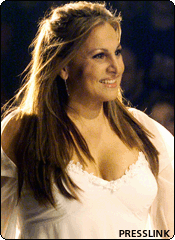
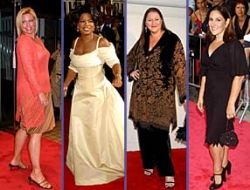
Some blurbs from People Magazine
What's Sexy Now?
Full-Figured
THE ATTITUDE
Trying to thrive in the late '80s as a size-12 model made her feel like "a sore thumb sticking out," says Emme, host of E!'s Fashion Emergency. "Finally, I got sick and tired of being told to conform my body to a standard it didn't fit." She embraced her size -- now a 16 -- and, along with women like Camryn Manheim, is making Hollywood take note that sex appeal can come in large packages.
THE LOOK
The full-figured woman, says designer Richard Metzger, "wants the same thing as any other consumer: to be trendy, luxurious." Most important: "Clothes should fit her curves, not cover them up."
******************
Stars Fill Out
Thin is still in? Not necessarily, according to the latest cover story in PEOPLE. In recent months, reports the magazine, a growing band of leading ladies -- among them Charlize Theron, Sandra Bullock, Drew Barrymore, Catherine Zeta-Jones and Jennifer Lopez -- have begun to say it loud and say it proud: Yes, they eat; yes, they enjoy it; and no, they are not finding that they have to be a size 0 to get work. "You know, when I put on 15 lbs. (after making 1994's 'Speed'), I was like, 'Oh my God!' " admits Sandra Bullock, 36. "But I didn't stop eating those cookies. It's actually liberating." Now resigned to the idea that "I'm never going to be thin and waiflike -- I tried, it's not going to work," Bullock tells PEOPLE that she's never been happier. The added pounds, she says, "round you out. I love my body now that it's softer."
Josefina Lopez


Film: Satin Rouge (2002)
un film de Raja Amari
avec Hiam Abbass (Lilia), Hend El Fahem (Salma), Maher Kamoun (Chokri), Monia Hichri (Folla), Faouzia Badr (la voisine)
production ADR Production & Nomadis Images
Scnario : Raja Amari
Ire assistante : Pamela Varela
Scripte : Sada Ben Mahmoud
Image : Diane Baratier
Son : Frdric De Ravignan
Dcors : Kas Rostom
Montage : Pauline Dairou
Montage son : Thomas Robert
Lilia est pour tous une "femme range" une mre ordinaire. Elle vit Tunis, avec sa fille Salma - adolescente - qu'elle lve seule depuis la mort de son mari. Par un coucours de circonstances et pour protger sa fille qu'elle croit la drive, Lilia se rend un soir dans un cabaret. Un monde nouveau s'ouvre elle, attirant et inquitant la fois, celui de la nuit, de la danse et des plaisirs. Elle ne peut s'empcher d'y retourner et se retrouve au fil des nuits "danseuse de cabaret". Par la danse, elle dcouvre ses dsirs enfouis sous des annes de devoirs. Elle va basculer de l'exemplaire mre de famille qu'elle n'est plus tout fait la femme de la nuit qu'elle n'est pas encore vraiment.
Avec son portrait d'une jeune veuve, Lilia, soudainement happe par la danse et la sensualit, la cinaste tunisienne russit un premier long mtrage subversif et troublant, loin des clichs habituels sur l'mancipation de la femme maghrbine (...) Jacques Mandelbaum - LE MONDE
Basic Plot:
A widow is drawn into bellydance culture while trying to protect her teenage daughter. Repulsed at first, she is soon dancing for audiences and romancing one of the musicians.
Kate Dillon
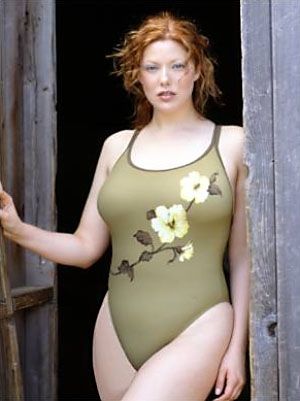
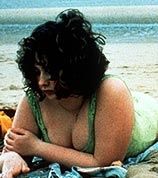
Fat Girl (2001)
A downbeat tale about the tortures of adolescence, A Ma Soeur! goes well beyond most people's worst childhood experiences. Everybody in Anas' family dumps their problems on her, while constantly reminding her that she's a helpless, chubby girl who can't stop eating. The only halfway decent relationship that she has is with her sister, Elena, who has some affinity with her, even though Elena often degrades her, blames her for her own faults, and is forced to drag her around when she's hunting for men. Director Catherine Breillat expertly captures these awkward years in the dialogue between the two sisters, the sometimes uncomfortable sex scenes, and in Anas' anguished facial expressions. The sex scenes are lengthy, graphic, and portray underage sex, but this sort of stuff is becoming de rigueur for contemporary French cinema. All of the acting is excellent, from Libero de Rienzo's performance as the slimy, Italian college student who shows off to Elena about other girls he's used and then dumped, to Arsinee Khanjian, as the sisters' emotionally unstable, chain-smoking mom, to Anas Reboux's Anas, who seems to have no hope in this world. The ending of the film is certainly controversial with some critics lashing out against it. But undoubtedly this is French cinema at its most fearless, a film one thinks about, discusses, and does not forget.
Mandy Barnett
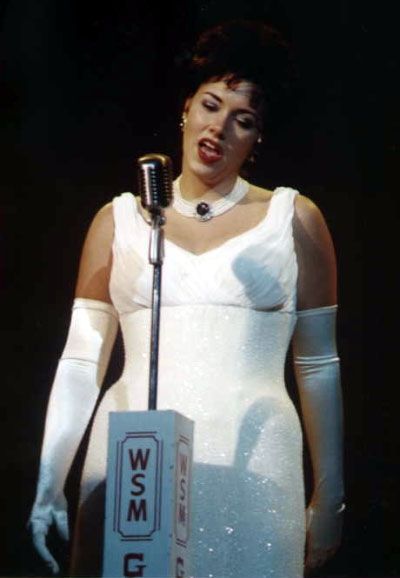
Mia Tyler
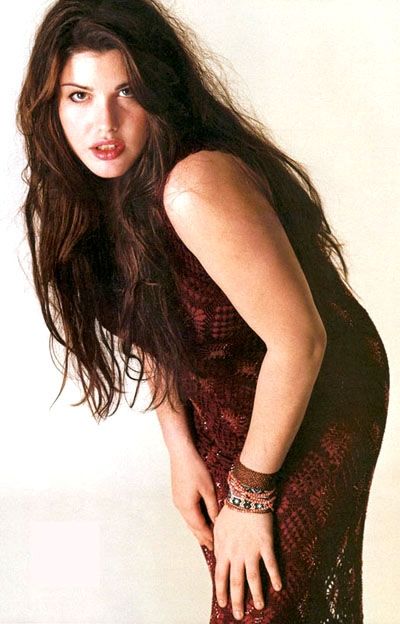
Mo'Nique
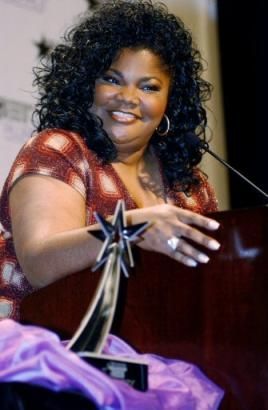
News: Mo'nique Loses 40 Pounds
Posted June 2, 2009
Larger-than-life comedienne/actress Mo'nique is not so large anymore after shedding 40 pounds (18.1 kilograms) in weight to please her worried husband.
The Soul Plane star, real name Monique Imes, admits she felt compelled to lose the weight after a heartfelt chat with her partner Sidney Hicks.
Mo'Nique tells Jet magazine she had ballooned to 262 pounds (118.8 kilograms) at one point, prompting her husband to tell her she was too big.
She explains, "I decided that I had to get some of that off of me. Sid and I had a conversation. What he said to me was motivation... He said, 'Baby, that's too much, and I want you for a lifetime.'"
A much healthier-looking Mo'Nique is now fighting reports she went to extreme lengths to lose the weight - via a gastric-bypass operation.
She adds, "I'm so scared of needles."
Instead, she made dietary sacrifices and stopped eating red meat and hit the gym.
She says, "This was truly making the commitment to watch what I eat and commit to working out. I stopped eating red meat. I want to say to big people, 'Let's be healthy big people.' Everybody can't be a size 0... but let's be healthy.'"
Mo'Nique is now determined to get her weight down to 200 pounds (90.7 kilograms).
Queen Latifah
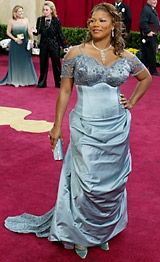
Sofie Dahl
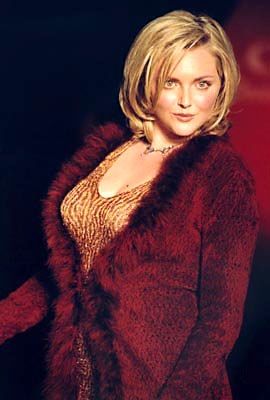
Kathy Bates
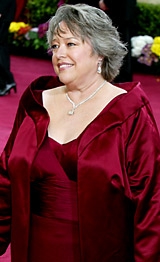
SA Blogs
- Big Fat Blog
Founded in August, 2000 by Paul McAleer and has its roots in size discrimination research he did in college. BFB focuses on the media as it did in 2000 but has expanded to support the fatosphere with an events calendar, forums, activism, and lots mor - Obesity Panacea
While working together at Queen's University, [the blog authors] were constantly discussing, or more accurately, ranting about, the latest weight loss gimmick that we had seen on television, online or in print. While some of these gimmicks (like the - Joy Nash
So... I'm an actress, activist and writer- brand new to blogging. Obviously. I make no claims to be good at it. I'm better at myspace. Way better. I'm working on a bunch of things... - First, Do No Harm
First, Do No Harm began when Barbara Benesch-Granberg told the tragic story of her mother's death - which followed decades of her being too afraid to see to a doctor who'd told her not to come back unless she lost 50 lbs. - the outpouring of similarl






